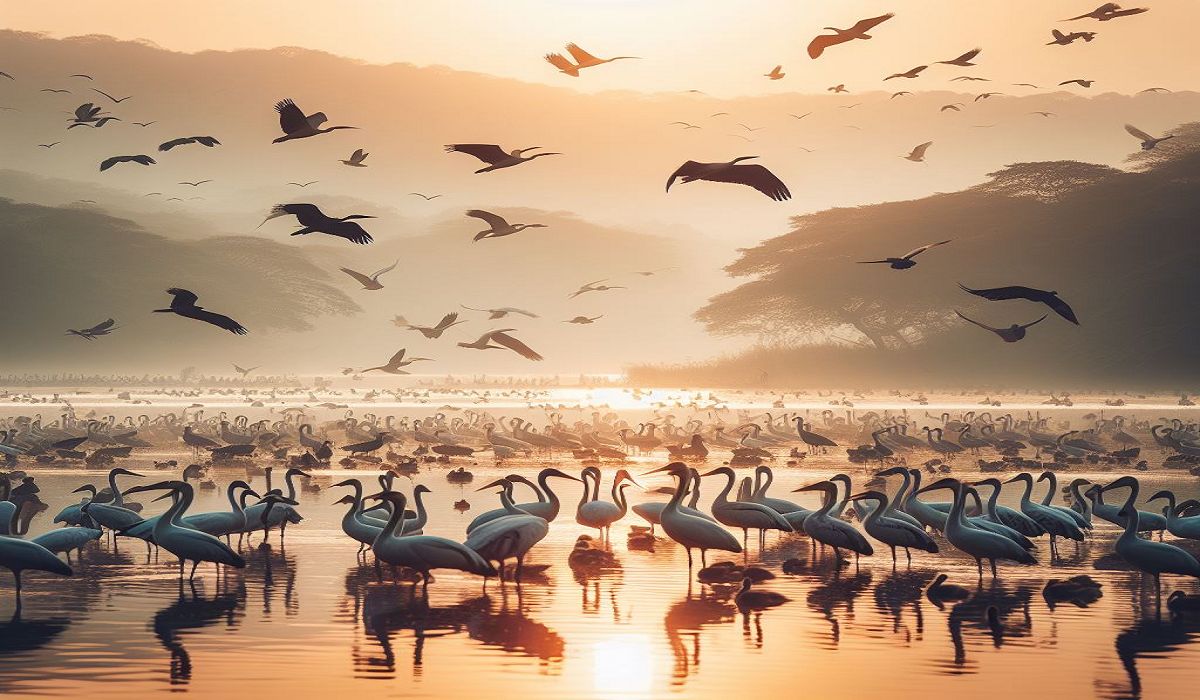India hosts a staggering diversity of migratory birds, with large flocks arriving from 29 different countries during September-October. These winged visitors play essential roles in ecosystems, aiding in pest control, seed dispersal, and providing organic fertilizers through their droppings. As part of the Central Asian Flyway spanning 30 nations, India’s key habitats like Pallikaranai, Pulicat Lake, Chilika lagoon, and Keoladeo National Park serve as critical stopover sites for migratory birds in India.
However, habitat loss, overexploitation, and climate change pose grave threats to their survival and life cycle. Protecting these areas and promoting sustainable practices is crucial for the conservation of these remarkable species.
1. Siberian Cranes

The Siberian Crane is the world’s third rarest crane listed as critically endangered on the IUCN Red List. The Siberian Crane, known scientifically as Leucogeranus leucogeranus, is on the brink of extinction and hails from the icy expanses of Russia’s arctic tundra. This amazing bird has bright white feathers and black feathers on its wings. Its face is red with a white stripe. An adult Siberian Crane can reach a stature of approximately 4 to 4.5 feet tall and tip the scales at about 4.5 to 6.5 kilograms. Its impressive wingspan stretches from 8 to 9 feet, and it boasts a body length of roughly 4.5 to 5.2 feet.
Migration and Distribution:
Historically, the Central Asian Flock of Siberian Cranes overwintered in wetlands in the Etawah and Mainpuri districts of India. After artificial wetlands were made in Bharatpur, Rajasthan, these cranes started coming often to the Bharatpur wetlands. They mostly stay in Keoladeo (Ghana) National Park during winter. However, in the winter of 2002/03, Siberian Cranes did not arrive in Keoladeo National Park, preceded by the worst drought in the park’s history, and since then, they have not been spotted anywhere in India. In May 2007, India nominated the Keoladeo (Ghana) National Park as a site in the WCASN (West/Central Asian Site Network) for the Siberian Crane and other waterbirds.
The western population of Siberian Cranes, of which Omid is the last known survivor, migrates from its breeding grounds in Siberia to its wintering grounds in northern Iran. In an effort to save this population, a female Siberian Crane named Roya was flown from a breeding center in Belgium to Iran in January 2023 to potentially mate with Omid.
Breeding and Population:
The global population of these migratory birds is estimated at around 3,800 divided into two populations.
Eastern Asian Population: Comprising 3,500-3,800 birds, accounting for over 98% of the global population. Their migration route covers approximately 6,000 km, crossing Russia from north to south with stopovers in northeast China before reaching Poyang Lake in China.
Western/Central Asian Population: Critically endangered, with only about 15-20 individuals remaining. Their usual path for migrating has been greatly disturbed. There are only some rumors about a few cranes seen along the Western and Central flyways, but nothing confirmed.
Visiting site for these migratory birds in India:
You can find Siberian Cranes in safe places in India, like Keoladeo National Park in Bharatpur, Rajasthan. Keoladeo National Park, which is now a UNESCO World Heritage Site, used to be home to many different kinds of birds and animals, including the Siberian Cranes. They also hang out in protected spots in China, like Poyang Lake in the middle of the Yangtze River, where they spend their winters.
Conservation Status:
The Siberian Crane is in big trouble. There aren’t many left, and they’re in danger of disappearing forever. People are mostly to blame because they’re destroying the places where these cranes live, like their breeding grounds in Siberia. People are cutting down forests, digging for resources like oil, and messing up the wetlands where the cranes stop during their travels.
Some people even hunt them. But there’s hope for these migratory birds. People are working hard to save the Siberian Crane. They’re fixing up their homes, helping them have babies in captivity, and keeping an eye on where they go. Some countries have agreed to work together to protect the Siberian Crane and where it lives. They made deals like the Convention on Migratory Species and the East Asian-Australasian Flyway Partnership to help keep these cranes safe.
2. Greater Flamingo
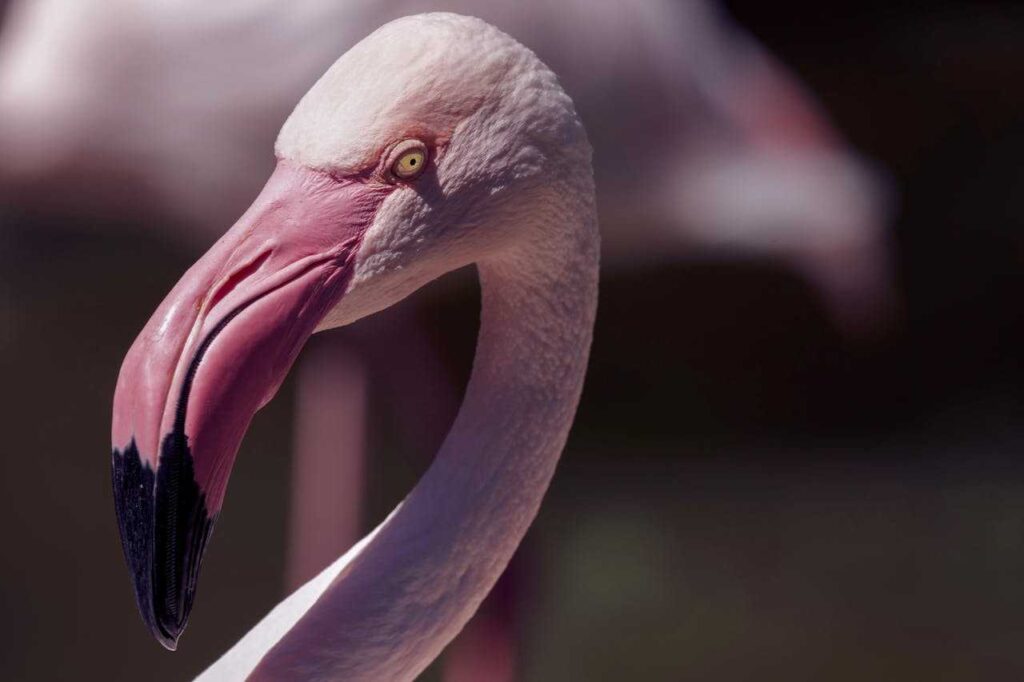
The Greater Flamingo is famous for its beautiful pink feathers and tall, graceful appearance. It’s the biggest type of flamingo and flies to India when it gets cold. Male Greater Flamingos can reach up to 61 inches tall and weigh about 3.6 kg. Luckily, they’re not in danger of disappearing according to the IUCN Red List.
Migration and Distribution:
Thousands of greater and lesser flamingos congregate around the wetlands of Mumbai, feeding on benthic animals like molluscs, crustaceans, and blue-green algae. The flamingos are thought to come largely from breeding grounds in the salt deserts of Gujarat, about 375 miles away, and some of the same birds return to Mumbai year after year.
These birds hang out in places like West Africa, Sub-Saharan Africa, the Mediterranean, and parts of Asia. However, climate change might be making them look for warmer spots when winter comes. They’re pretty active travelers, moving around to find good food and safe spots, especially during mating season. They’re known to cover about 372 miles in one night during migration, zooming at speeds up to 31-37 mph. They love wetlands, lakes, and marshes, and you’ll spot lots of them during winter. Every November, they head to India and stick around until June when the monsoon arrives.
Why do they move around so much? Mainly to find food, escape overcrowded places, avoid predators or humans, or dodge droughts or floods. Some just want to warm up during chilly winters.
Breeding and Population:
Greater Flamingos are pretty romantic. They stick with one partner for a season and have their babies in large groups. They make their nests in large groups, sometimes with up to 20,000 pairs or even more. Breeding usually happens between March and June. During this period, they put on fancy group displays to attract mates, showing off synchronized dances and waving their heads in a stylish manner.
As for numbers, there are quite a lot of them—between 550,000 to 680,000 worldwide. They’re not considered endangered, which is good news. The population of one group, the Southern African Greater Flamingos, is about 800,000. They breed in about 25 spots across Africa, the Mediterranean, and even as far as India.
Visiting site for these migratory birds in India:
Greater flamingos is a well known migratory bird in India. Every year it comes from places like Afghanistan, Pakistan, and Israel. Key locations in India where flamingos can be spotted include:
- Sewri Mudflats in Mumbai
- Chilika Lake in Odisha
- Bhigwan in Maharashtra
- Pulicat Lake is in both Andhra Pradesh and Tamil Nadu
- Rann of Kutch in Gujarat
- Thane Creek Flamingo Sanctuary near Mumbai
The Thane Creek wetlands provide prime feeding habitat for the flamingos, with abundant cyanobacteria (blue-green algae) that are the main food source, especially for the lesser flamingos. More flamingos are seen in Mumbai because sewage and nutrients are going into the creek, making more cyanobacteria grow. Also, mud building up in the creek gives them more places to find food. The flamingos’ presence has become a source of pride for Mumbai residents, with annual festivals and runs held to raise awareness, and a 1,700 hectare flamingo sanctuary has been designated.
Conservation Status:
While they’re not critically endangered, they’re still protected in India by laws like the Wildlife Protection Act of 1972. In one area, about 565 of them were counted, showing they’re still doing okay. However, threats to the flamingos remain, including a bridge under construction and potential impacts from mangrove growth encroaching on the mud flats. The Bombay Natural History Society is conducting a 10-year study to monitor the flamingos and their habitat.
3. Ruff
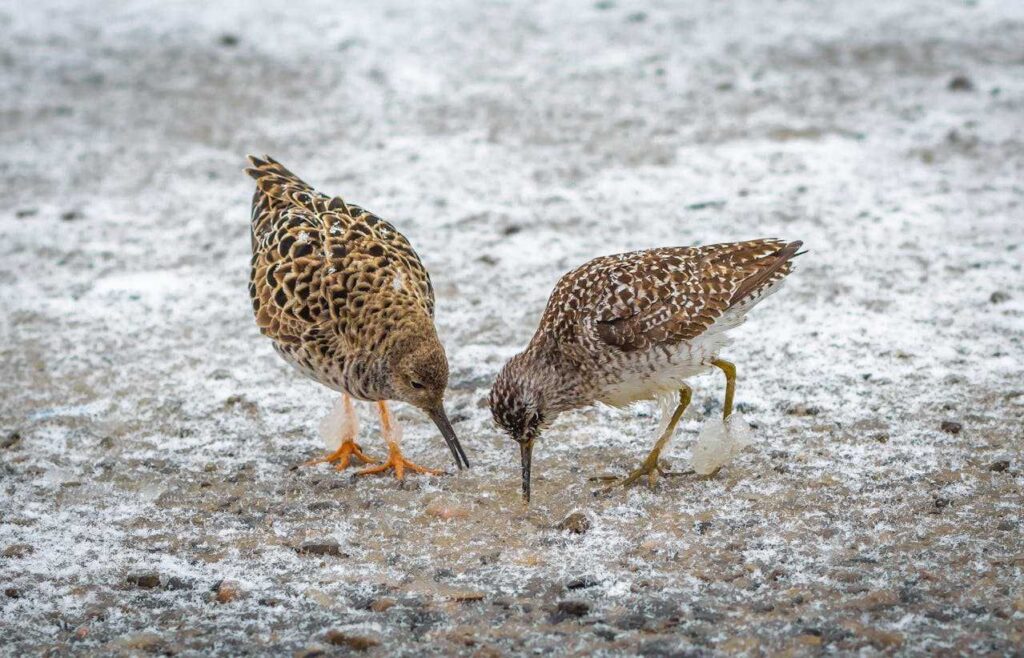
The Ruff is a medium-sized bird that likes to live in wet areas like marshes and meadows in the north of Europe and Asia. When it gets cold, they fly to warmer places like southern Europe, Africa, parts of Asia, and Australia for the winter. The male ruff is much larger than the female (“reeve”) and has a distinctive breeding plumage with brightly colored head tufts, bare orange facial skin, and a large collar of ornamental feathers.
Migration and Distribution:
The autumn migration starts in late June/early July for males, mid-July for females, and late July to August for juveniles. Some non-breeding Ruffs remain in the wintering areas and do not migrate to the breeding grounds.
Ruffs are highly gregarious, forming large flocks during migration and on the wintering grounds. Some birds from Siberia travel back and forth each year for up to 30,000 kilometers. Their diet consists primarily of insects during the breeding season, but also includes seeds, grains, and other plant material on migration and in the winter.
Breeding and Population:
The ruff bird is a medium-sized bird that lives in marshes and wet fields in parts of Europe and Asia. The male ruff is bigger than the female and has fancy feathers during mating season, like colorful head tufts and a big collar of feathers. The female and males outside of breeding season have more plain feathers. The female makes a hidden nest on the ground, sits on the eggs, and takes care of the babies alone.
The worldwide number of Ruff birds is guessed to be between 2,000,000 and 2,600,000. Sadly, overall, their numbers are going down. But in Eastern Russia, some groups of these birds seem to be staying the same or even growing.
Ruffs are not often seen, but sometimes they show up unexpectedly in North America. They’re usually alone in groups of yellowlegs. However, the provided content does not specify details on the migration of Ruffs to India, such as migration routes, timing, or numbers.
Visiting site for these migratory birds in India:
Bharatpur Bird Sanctuary, also called Keoladeo National Park, is a popular spot for bird watching in India. It’s in the state of Rajasthan in the northwest. There are more than 370 types of birds living there. Ruff birds are often seen by tourists visiting here.
Conservation Status:
The Ruff bird is not in immediate danger worldwide, so it’s labeled as “Least Concern.” But in Europe, it’s getting a bit risky because it’s losing its homes, wetlands are getting drained, and people are hunting them too much. That’s why it’s included in a conservation agreement called AEWA, because in many places where it lives, its numbers are dropping.
4. Northern Shoveler
Northern shovelers eat by searching for plants in the water, moving their bills from side to side to catch food. Their bill is special and shaped like a shovel, which helps them find small animals like insects and plankton in the water. Their bill has small comb-like structures that act like filters, so they can catch food easily.
This special bill gives them an advantage over other ducks because they don’t have to compete for food as much. They like to live in marshes with lots of bugs and small creatures. The female shovelers look plain brown like other ducks, but they have long bills that are grayish-orange on the bottom part. They are about 19 inches long, with wings that span about 30 inches, and they weigh around 1.3 pounds.
Migration and Distribution:
The Northern Shoveler duck flies from cold places like the Arctic and Europe to warmer areas like India during winter. In India, they often hang out in places like the Yamuna River, Okhla Bird Sanctuary, Najafgarh Drain, Sultanpur wetlands, and Bhalswa Horseshoe Lake.
They stay in these wetlands until it gets warmer up north. These ducks are important for these places in India, showing why it’s vital to keep these habitats safe. During summer, they live in northern areas of Europe, North America, and Asia, where they have their babies. After that, they fly back south for the winter to places like the United States and South America.
Breeding and Population:
Northern Shovelers start getting ready to have babies around December when they’re still in their winter homes. The boy ducks start trying to impress the girl ducks. By January, most of them have found a partner, and they head back to where they were born to have their babies.
They usually pick a spot near water to build their nests, usually around May. The girls spend about a week picking the perfect spot and making their nests comfy with grass and feathers. They lay about one egg a day until there are around 8 to 12 eggs in the nest. It takes about three weeks for the eggs to hatch, and when they do, the mom takes her babies to the water within a day.
The babies grow up fast, and within about two months, they’re able to fly. In India, you can find these ducks in places like Keoladeo National Park and Nal Sarovar Bird Sanctuary. They’re pretty common, with around 5.9 million of them around.
Visiting site for these migratory birds in India:
Some specific wintering sites for these ducks in India include:
- Chilika Lake
- Wetlands just south of the Himalayas
Conservation Status:
The Northern Shoveler is not listed as a critically endangered species on the IUCN Red List, but it is protected under the Wildlife Protection Act, 1972, in India. As far as we know, the Northern Shoveler is not in big trouble right now.
But we need to keep an eye on them and make sure their homes stay safe. It’s important to protect places like wetlands and make sure there’s enough clean water for them to live in. This helps make sure they’ll be around for a long time.
5. Rosy Pelican

The Rosy Pelican, also known as the Great White Pelican (Pelecanus onocrotalus), is a widely distributed species found in Asia, Europe, and Africa. It is a large bird, slightly bigger than a vulture, with a length of 140-183 cm and a wingspan of 226 to 360 cm.
Rosy Pelicans are gregarious and prefer to forage in large flocks, though they can also hunt alone. In their African breeding grounds, they can account for 10-25% of the fish stocks in lakes, leading to potential conflicts with humans. The reddish-pink color of their neck and breast feathers is believed to come from ferric oxide in the silt of their African habitats, which may explain why the birds seen in India had paler feathers compared to stock photos.
The adult males weigh 9.0 to 15.0 kg, while the females are smaller, measuring about 148 cm and weighing 5.4 to 9 Kg. The plumage is whitish in adults, while immature birds have grey plumes.
Migration and Distribution:
Rosy Pelicans are good flyers, migrating annually from Africa to India. They have a very efficient, gliding flight pattern once airborne. Rosy Pelicans are one of the 10 migratory birds that visit India every winter. During the time when they make babies, migratory groups of these birds are seen from Eastern Europe to Kazakhstan. Wintering locations include northeastern Africa through Iraq to north India, with a large number wintering around Pakistan and Sri Lanka.
The Great White Pelican species prefer large, warm, shallow water bodies surrounded by reed beds and dense vegetation. They inhabit freshwater and saline lakes, estuaries, mudflats, creeks, and ponds. They feed mainly on fish and can consume up to 4 kg of fish in a day. The gular pouch serves as a scoop during fishing and as a net to store the catch.
Breeding and Population:
The breeding season for the Great White Pelican varies depending on the region. In temperate zones, they breed in April or May, while in Africa, they breed throughout the year. In India, the breeding season ranges from February to April. Many pelicans mate in groups, and the female pelicans lay between one and four eggs at a time. Both parents take care of the young, which fledge at 65 to 75 days of age.
Male animals that are ready to mate have pink skin on their faces. The female animals have orange skin on their faces during mating season. In the Palearctic region, 6,700 to 11,000 breeding pairs were found in the 1990s, with the largest colony in the Danube Delta in Romania. The African population is estimated at around 75,000 pairs, while the overall global population is not precisely known but is thought to be declining in some areas.
Visiting site for these migratory birds in India:
They can be found in large flocks at places like the Keoladeo National Park in Bharatpur, Rajasthan.
Conservation Status:
The Great White Pelican is not listed as a critically endangered species on the IUCN Red List, but it is protected under the Wildlife Protection Act, 1972, in India. The species is threatened by habitat destruction, human activity in the breeding habitat, fishing activities, and hunting. The IUCN has categorized and evaluated these pelican species and has listed them as of “Least Concern”. However, the species is declining in some regions due to various threats.
6. Gadwall

The Gadwall (Mareca strepera) is a dabbling duck that is widely distributed in the Northern Hemisphere. It breeds in the lowlands of central, eastern, and northwest England, eastern Scotland, Orkney, the Uists, and sporadically in Switzerland. It is a medium-sized dabbling duck that measures 46-56 cm in length and weighs 635-1200 g.
The Gadwall is a shy species and can be difficult to identify, especially the females. The male has a distinctive pattern on the chest and back, while the female has a thinner, darker bill than the female Mallard. The Gadwall can be observed on various waters, including lakes, ponds, marshes, and even harbor areas, lidos, or bathing meadows in winter.
Migration and Distribution:
The Gadwall is a bird that travels varying distances, with some flying over 4000 km to their winter homes. There are about 4.4 million Gadwalls around the world, making them quite common. In Switzerland, they’re not often seen breeding, but occasionally they do on Lakes Neuchâtel, Lake Constance, and Klingnauer Stausee. During winter, around 8000 Gadwalls visit Swiss waters each year. However, this number can change a lot from year to year. When winters are cold, more Gadwalls come to Switzerland, but fewer arrive during very mild winters.
The purpose of their migration to India is primarily for wintering and feeding, as they feed on a variety of aquatic plants and invertebrates found in wetland habitats across the country. These wetland habitats also provide suitable areas for Gadwalls to rest and roost, allowing them to conserve energy. After spending the winter in India, Gadwalls typically leave in the months of February and March, returning to their breeding grounds in Europe and Asia to begin the breeding season.
Breeding and Population:
These migratory birds breed in the northern parts of Europe and Asia, including regions like Siberia, Scandinavia, and Russia. During the winter months, between October and February, Gadwalls arrive in India, where they can be found in various states like Punjab, Haryana, Rajasthan, Gujarat, and Andhra Pradesh. The breeding season for Gadwalls begins in spring, with peak migration occurring in March. The majority of pairs reach their breeding grounds by early April. Breeding behavior is similar to other ducks, with the female taking care of the young alone. The nest is well hidden in the shore vegetation.
Gadwalls nest in tall, emergent vegetation near water. The female lays 8 to 12 eggs, which hatch after 24 to 26 days. The young leave the nest soon after hatching and are guided and protected by the mother for 45 to 50 days. Additionally, the global population of Gadwalls is estimated to number between 3,200,000 to 3,800,000 individuals (as of 2006). In Great Britain, there aren’t many Gadwalls that make babies and stay there, but they do come to visit during winter. Lately, there have been more of them than before.
Visiting site for these migratory birds in India:
The Gadwall is a migratory bird that visits India every year. Gadwalls are often seen in freshwater marshes and reedy habitats. Here are some places where you can spot them:
1) Chilika Lake, Odisha
2) Keoladeo National Park (formerly Bharatpur Bird Sanctuary), Rajasthan
Conservation Status:
The Gadwall is one of the birds protected by the Agreement on the Conservation of African-Eurasian Migratory Waterbirds (AEWA). Gadwall is not listed as a critically endangered species on the IUCN Red List. However, it is protected under the Wildlife Protection Act, 1972, in India. The species is threatened by habitat destruction, human activity in the breeding habitat, fishing activities, and hunting.
7. Black-tailed Godwit
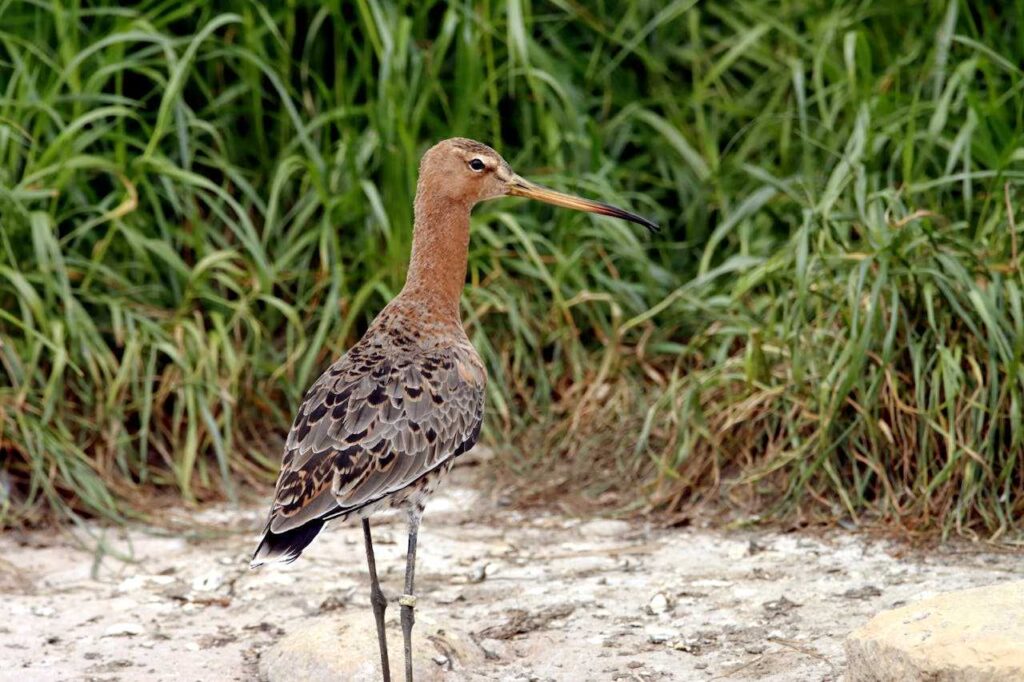
Black-tailed Godwits are birds that like to stay in water and eat lots of different things like insects, worms, and small creatures. They search for food both on the ground and in shallow water, picking up insects and other small animals.
These birds, called Black-tailed Godwits, are easy to recognize. They have a long, straight beak that curves a little bit upwards, long skinny legs, and a pattern of black and white stripes on their head and neck. They’re not very big, about 37 to 44 centimeters tall, and they’re known for flying fast, reaching speeds up to 60 kilometers per hour.
In the winter, their feathers turn a pale grayish-brown color. They have light markings above their eyes and dark areas around them. There are dark lines on their back and wings, and their tails are black. Their beaks are long and straight, with an orange-yellow color near the base and getting darker towards the end. When they fly, you can see their white wing stripes, white rump, and dark tail feathers clearly.
Migration and Distribution:
The Black-tailed Godwit is a bird that travels a lot. They breed in places like Iceland, Europe, and parts of Asia, then fly south for the winter. They travel long distances during migration, usually from July to October. In the winter, they come back to where they breed, usually from February to April.
These birds can be found in many places around the world, like the Indian subcontinent, Southeast Asia, Australia, Europe, Africa, and Asia. There are different types of Black-tailed Godwits, and they have their own patterns for migration and breeding. For example, some breed in Iceland and spend the winter in Europe, while others breed in Iceland and go to the British Isles for the winter.
Overall, there are a lot of Black-tailed Godwits out there, with around 4.4 million of them. They’re known for flying long distances and traveling between different parts of the world throughout the year.
Breeding and Population:
Black-tailed Godwits make their homes in places like wet grasslands, marshes, and sometimes sandy areas. They build their nests together in groups and stay faithful to their partners. Both parents help make the nest and take turns keeping the eggs warm until they hatch.
These birds travel long distances between where they breed and where they spend the winter. They fly together in groups and take breaks at stopover sites along the way. These rest stops are crucial for them to eat and rest during their journey.
They use their sensitive beaks to find food, especially in muddy areas where they can dig for prey. Male Black-tailed Godwits are usually bigger and heavier than females.
Their migration routes cover places like the Indian Subcontinent, Australia, West Africa, and parts of Western Europe. But they face a big problem: losing their homes because people are changing their habitats, like draining wetlands for building dams or farming. This puts them in danger because they have nowhere to live.
Visiting site for these migratory birds in India:
During the non-breeding season, these migratory birds of India travel thousands of kilometers to their wintering grounds. In India, they can be found in coastal wetlands, mudflats, estuaries, and marshes in states like Gujarat, Maharashtra, Tamil Nadu, and Andhra Pradesh. Arrive in India from September to November and stay until March, using the wetlands to rest and feed on aquatic invertebrates.
Conservation Status:
Black-tailed Godwits are listed as “Near Threatened” on the IUCN Red List of Threatened Species due to a decline in their population. The main threats to Black-tailed Godwits are habitat loss and degradation, hunting, and climate change. They are protected under the Wildlife Protection Act, 1972, in India and are a priority species under the UK Post-2010 Biodiversity Framework.
To help them, people are working on protecting and fixing up the places where they live, like wetlands and marshes. They’re also trying to reduce the effects of climate change on where these birds breed and spend the winter. It’s important for different countries to work together to save them because they travel through many places during the year.
8. Amur Falcon
The Amur Falcon is a small bird of prey that belongs to the falcon family. Male Amur Falcons look striking during the breeding season with their dark blue backs, reddish-brown underparts, and faces. Females and non-breeding males look less colorful with brownish-gray feathers. They are small raptors, with males typically measuring around 25–30 cm in length, and females a bit larger. Amur Falcons weigh between 160–200 grams. They are long-distance migrants, traveling annually from eastern Asia to southern Africa and back.
Migration and Distribution:
When autumn starts, these falcons leave where they were born in Asia and fly to places in northeast India and Bangladesh. These areas serve as resting points for their flights across India. In northeast India, they gather in flocks numbering thousands, feeding and resting before continuing their journey.
The most remarkable part of their migration is when they cross the Indian Ocean between western India and tropical East Africa, covering a distance of over 4,000 kilometers. They arrive late in eastern Africa during autumn due to their adaptation to strong monsoon tailwinds. They reach their southern African winter range around November-December and leave by early May.
Breeding and Population:
Until recently, the Amur Falcon was not widely known in India. In 2012, a report revealed that between 120,000 and 140,000 Amur Falcons were being trapped and killed for human consumption in just one location in Nagaland each year. This led to international outcry and conservation efforts.
Visiting site for these migratory birds in India:
In India, the Amur Falcons often stop in the northeastern states of Nagaland, Manipur, and Mizoram. These areas provide suitable habitat and food for the birds. The Doyang reservoir in Nagaland is a major stopover site for them.
Conservation Status:
The large-scale hunting of Amur Falcons in Nagaland gained international attention. The Indian government banned hunting, and conservation education programs were initiated. Local communities in Nagaland began protecting the falcons when they arrived in October 2013. Conservation efforts have been successful, and hunting pressure has decreased significantly.
9. Comb Duck
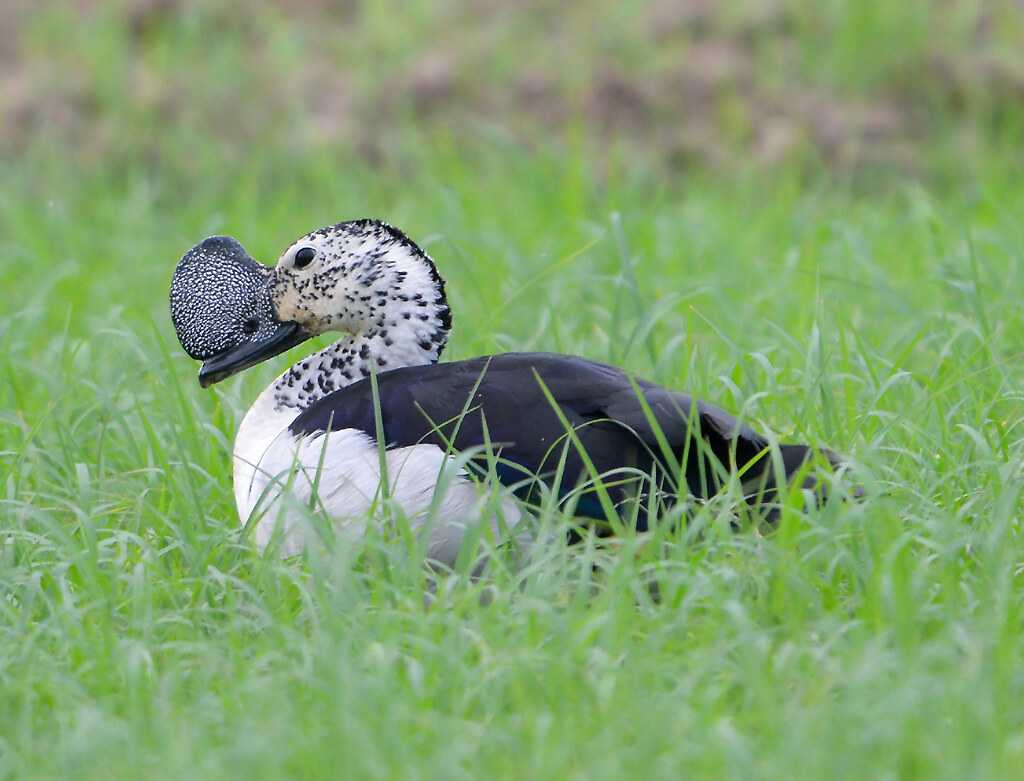
Attribution: Image by Koshy Koshy, Flickr under license CC BY 2.0 DEED.
The Comb duck, also called the American comb duck (Sarkidiornis sylvicola), is a fascinating water bird found in tropical wetlands in South America. They are often seen swimming in shallow water, eating plants, seeds, insects, and small creatures. Their appearance is striking with a big, dark body and white marks on their wings. The males have a unique knob on their bills, giving them their name.
Males are about 76 cm long and weigh around 2250 g, while females are smaller at 56 cm long and about 1750 g. Males have a black knob on their bills, a creamy white head, an orange-yellow neck, and yellow or cinnamon sides. Both males and females have black bills, but only males have the comb on top.
Migration and Distribution:
Comb Ducks move around within India instead of flying long distances to other continents. They change where they go based on the habitat and food they need. They come to India between April and May to breed and leave by October.
Comb Ducks are amazing because they travel all the way from Madagascar to find good places to have babies in India. They live in wet areas like marshes, lakes, and rivers in different parts of the world, like Africa, Asia, and South America.
Breeding and Population:
Comb Ducks start having babies when they’re 1-2 years old. They make nests in trees or on the ground during the rainy season. Females lay 6-20 eggs, and both parents take care of them. The babies leave the nest after about 10 weeks. The number of Comb Ducks in the world is between 25,000 and 100,000.
In different parts of the world:
- West Africa: 20,000 to 40,000 ducks
- Southern and Eastern Africa: 50,000 to 250,000 ducks The whole world population has at least 10,000 grown-up ducks and is going down a bit but not breaking into small groups.
Visiting site for these migratory birds in India:
You can see Comb ducks mainly in northern India, especially in Haryana state. You might also find them in national parks like Sultanpur, Manas, Batla, and Corbett.
Conservation Status:
Even though Comb Ducks aren’t in big trouble globally, they face dangers like losing their homes, dirty water, and hunting in some areas. It’s important to save and fix their wetland homes to make sure Comb Ducks and other water birds can keep living well. Overall, Comb Ducks are interesting birds that play a big part in wetland places all over the world.
10. Blue tailed Bee-eater
The Blue-tailed Bee-eater (Merops philippinus) is a fascinating bird seen across South and Southeast Asia. It’s a slender bird with colorful feathers, mostly green with a blue spot on its face, a black stripe by its eyes, and a yellow and brown throat. Its tail is bright blue, and its beak is black. Its feet have three toes joined at the base. It can grow to be 23–26 cm long, including two long tail feathers.
These birds like to be near water and live in open areas close to water bodies. They eat flying insects like bees, wasps, and hornets. They catch bugs while flying from a perch and then hit them against the perch to break them open. Their calls sound like rolling chirps and whistles. The only similar bird in their area is the blue-cheeked bee-eater, but it lives in drier places. The Blue-tailed Bee-eater has a blue rump and tail, while the blue-cheeked bee-eater is green. Also, the Blue-tailed Bee-eater’s under-tail feathers are blue, but the blue-cheeked bee-eater’s are green.
Migration and Distribution:
Breeding and Summer Residence-
During the breeding season, from April to September, Blue-tailed Bee-eaters make homes in places like India and China. They show up when bees are around, and they stick around in Asia during the warm months.
These colorful birds have mostly green-brown feathers, with a thin blue stripe on their faces. And like their name says, their tail feathers are a pretty blue color.
Winter Migration-
When winter comes, many Blue-tailed Bee-eaters from South Asia start an amazing trip. Birds fly to the south where it’s warmer.
They go to places like South India and Sri Lanka for the winter. Like European Blue-tailed Bee-eaters, they travel during the day, and you can hear their special sounds even if you can’t see them.
Breeding and Population:
In India, groups of Blue-tailed Bee-eaters make homes together by digging holes in sandy or soft soil banks. They lay a bunch of eggs, usually 2 to 5, which both parents sit on to keep warm. After about 20 days, the babies hatch, and both parents take turns feeding and looking after them.
We don’t know exactly how many Blue-tailed Bee-eaters there are worldwide, but they’re thought to be not very common to locally common. In China and Taiwan, estimates suggest there might be between 100 to 10,000 pairs of birds breeding, and during migration, there might be 50 to 1,000 individual birds.
Visiting site for these migratory birds in India:
Blue-tailed bee-eaters are commonly found in the river valleys of rivers like Godavari, Kaveri, and Tunga Badra. They bring a burst of color to our landscapes and remind us of the intricate web of life in our natural surroundings.
Conservation Status–
While Blue-tailed Bee-eaters are not considered globally threatened, they face various threats such as habitat loss, pollution, and pesticide use. Conservation efforts focused on protecting their breeding and wintering habitats, as well as raising awareness about their conservation needs, are essential for their long-term survival.
Overall, the migration of Blue-tailed Bee-eaters adds to the biodiversity of India’s ecosystems and provides opportunities for birdwatchers and nature enthusiasts to observe these beautiful birds in their natural habitat.
FAQs
What is a well-known migratory bird renowned for its extensive travel?
The Arctic tern is celebrated for its remarkable migratory journey, covering the vast distance between its breeding grounds in the Arctic to its wintering grounds in the Antarctic each year, setting the record for the longest migration among birds.
Can you list some migratory birds found in India?
In India, you can spot several migratory birds such as the Rufous-tailed Rock-Thrush, Rufous-tailed Scrub-Robin, Rufous-tailed Shrike, and Rufous-tailed Wheatear among others.
Why do birds migrate?
The primary reason birds migrate is to seek more favorable living conditions. Many birds fly from cold places where they breed in the north to warmer places in the south for winter. Sometimes, birds in Africa have different habits. Instead of staying in one place all year, some birds breed in the south and then travel north when it gets cold. Others might move to the coast where it’s warmer during the winter.
Which migratory birds regularly visit India?
India is a regular host to a variety of migratory birds, including the great-spotted woodpecker, great grey owl, Siberian crane, waxwing, greater flamingo, coal tit, among others, making their annual journey to the country.
References
[1] – https://www.downtoearth.org.in/blog/wildlife-biodiversity/how-important-are-migratory-birds-in-an-era-of-climate-change-75588 [2] – https://optimizeias.com/importance-of-migratory-birds-in-an-era-of-climate-change/ [3] – https://www.wwfindia.org/news_facts/feature_stories/world_migratory_bird_day [4] – https://www.cms.int/siberian-crane/en/page/species-conservation-0 [5] – https://www.cms.int/siberian-crane/en/page/india [6] – https://savingcranes.org/2023/02/a-dream-for-hope/ [7] – https://timesofindia.indiatimes.com/travel/things-to-do/where-to-spot-flamingos-in-india/articleshow/106640338.cms [8] – https://peapix.com/bing/35357 [9] – https://www.smithsonianmag.com/travel/mumbai-is-embracing-100000-flamingos-that-winter-on-its-coast-180981343/ [10] – https://en.wikipedia.org/wiki/Ruff_(bird) [11] – https://ebird.org/india/species/ruff/IN [12] – https://www.oiseaux-birds.com/card-ruff.html [13] – https://www.thehindu.com/sci-tech/energy-and-environment/the-northern-shoveler-in-the-house/article37260045.ece [14] – https://timesofindia.indiatimes.com/travel/destinations/from-bluethroat-to-northern-shoveler-migratory-birds-that-can-be-spotted-in-delhi-now/photostory/106890793.cms [15] – https://en.wikipedia.org/wiki/Northern_shoveler [16] – https://anotherglobaleater.wordpress.com/2019/04/30/rosy-pelican/ [17] – https://www.outlooktraveller.com/ampstories/experiences/nature/10-migratory-birds-that-visit-india-every-winter [18] – https://homegrown.co.in/homegrown-explore/lifestyle/these-beautiful-birds-all-migrate-to-india [19] – https://en.wikipedia.org/wiki/Great_white_pelican [20] – https://greenverz.com/gadwall/ [21] – https://en.wikipedia.org/wiki/Gadwall [22] – https://indianbirds.thedynamicnature.com/2015/03/gadwall-anas-strepera.html [23] – https://www.worldmigratorybirdday.org/2017/species/black-tailed-godwit [24] – https://en.wikipedia.org/wiki/Black-tailed_godwit [25] – https://greenverz.com/black-tailed-godwit/

